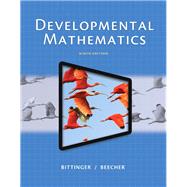The Bittinger Worktext Series recognizes that math hasn’t changed, but students–and the way they learn math–have. This latest edition continues the Bittinger tradition of objective-based, guided learning, while also integrating timely updates to the proven pedagogy. This edition has a greater emphasis on guided learning and helping students get the most out of all of the resources available, including new mobile learning resources, whether in a traditional lecture, hybrid, lab-based, or online course.
NOTE: Before purchasing, check with your instructor to ensure you select the correct ISBN. Several versions of Pearson's MyLab & Mastering products exist for each title, and registrations are not transferable. To register for and use Pearson's MyLab & Mastering products, you may also need a Course ID, which your instructor will provide.
Used books, rentals, and purchases made outside of Pearson
If purchasing or renting from companies other than Pearson, the access codes for Pearson's MyLab & Mastering products may not be included, may be incorrect, or may be previously redeemed. Check with the seller before completing your purchase.
0134115864 / 9780134115863 Developmental Mathematics Plus MyMathLab with Pearson eText -- Access Card Package
Package consists of:
0321431308 / 9780321431301 MyMathLab -- Glue-in Access Card
0321654064 / 9780321654069 MyMathLab Inside Star Sticker
0321997174 / 9780321997173 Developmental Mathematics








